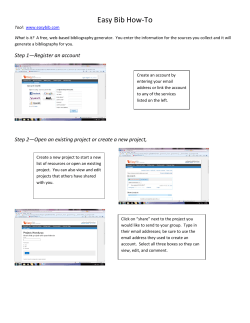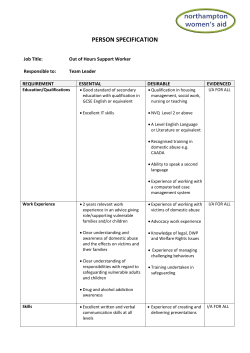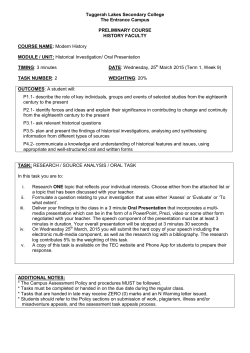
Best Foot Forward â Navigating the New NIH Biosketch
Best Foot Forward – Navigating the New NIH Biosketch David Carroll PhD Director, Research Funding development, NC TraCS Nov 28, 2014 - NOT-OD-15-024 announces new biosketch format, effective 1/25/2015 Dec 5, 2014 – NOT-OD-15-032 pushes implementation date to 5/25/2015 New page limit Include up to four refs that highlight your experience and qualifications NIH announced this provision in 2011 NOTOD-11-045, but this is the first explicit mention in the biosketch Describe up to 5 contributions to science Include up to four refs supporting each Contribution URL to entire bibliography Old Format New Format 4 page limit Personal Statement 5 page limit Personal Statement + 4 refs 5 contributions to Science + 4 refs each Up to 24 selected refs Link to online bibliography 15 selected refs New Biosketch Formats for • Research Grant applications • Predoctoral Fellowship applications • Postdoctoral Fellowship applications http://grants.nih.gov/grants/funding/424/index.htm#format “Significant Contributions to Science” • indicate the historical background that frames the scientific problem • the central finding(s) • the influence of the finding(s) on the progress of science or the application of those finding(s) to health or technology • your specific role in the described work. C. Contribution to Science My early publications directly addressed the fact that substance abuse is often overlooked in older adults. However, because many older adults were raised during an era of increased drug and alcohol use, there are reasons to believe that this will become an increasing issue as the population ages. These publications found that older adults appear in a variety of primary care settings or seek mental health providers to deal with emerging addiction problems. These publications document this emerging problem but guide primary care providers and geriatric mental health providers to recognize symptoms, assess the nature of the problem and apply the necessary interventions. By providing evidence and simple clinical approaches, this body of work has changed the standards of care for addicted older adults and will continue to provide assistance in relevant medical settings well into the future. I served as the primary investigator or co-investigator in all of these studies. a. Gryczynski, J., Shaft, B.M., Merryle, R., & Hunt, M.C. (2002). Community based participatory research with late-life addicts. American Journal of Alcohol and Drug Abuse, 15(3), 222-238. b. Shaft, B.M., Hunt, M.C., Merryle, R., & Venturi, R. (2003). Policy implications of genetic transmission of alcohol and drug abuse in female nonusers. International Journal of Drug Policy, 30(5), 46-58. c. Hunt, M.C., Marks, A.E., Shaft, B.M., Merryle, R., & Jensen, J.L. (2004). Early-life family and community characteristics and late-life substance abuse. Journal of Applied Gerontology, 28(2),26-37. d. Hunt, M.C., Marks, A.E., Venturi, R., Crenshaw, W. & Ratonian, A. (2007). Community-based intervention strategies for reducing alcohol and drug abuse in the elderly. Addiction, 104(9), 1436-1606. PMCID: PMC9000292 “indicate the historical background that frames the scientific problem” “the central finding(s)” “the influence of the finding(s) on the progress of science or the application of those finding(s) to health or technology” “your specific role in the described work” Addresses “Science”, rather than the specific application – will require only gradual updating (unlike Personal Statement) Keep it short and simple • You’re allowed ½ page per – don’t feel like to have to fill up the page • You’re allowed 5 items – you don’t have to include 5. • Bullet points • Be realistic about what is considered “significant” What is the junior investigator to do? • Citation# / H-index • Doctoral work Contributions references can be pretty much anything…… “For each of these contributions, reference up to four peer-reviewed publications or other non-publication research products (can include audio or video products; patents; data and research materials; databases; educational aids or curricula; instruments or equipment; models; protocols; and software or netware) that are relevant to the described contribution. The description of each contribution should be no longer than one half page including figures and citations.” Other than link to biblio, URLs still not permitted in biosketch, but “non-standard” items can be included in bibliography and cited in bio On-Line Bibliography • Set it up now, not in May • myNCBI – Manage lit searches – Bibliography – http://www.ncbi.nlm.nih.gov/myncbi/browse/coll ection/47226327/?sort=date&direction=ascendin g – sciENcv For an annotated PDF version of this presentation: d_carroll@unc.edu NIH Office of Extramural Research (OER) Biosketch FAQs: http://grants.nih.gov/grants/policy/faq_biosketches.htm#4388 UNC Health Sciences Library and HSL Research Hub http://guides.lib.unc.edu/compliance/myncbisetup
© Copyright 2025












